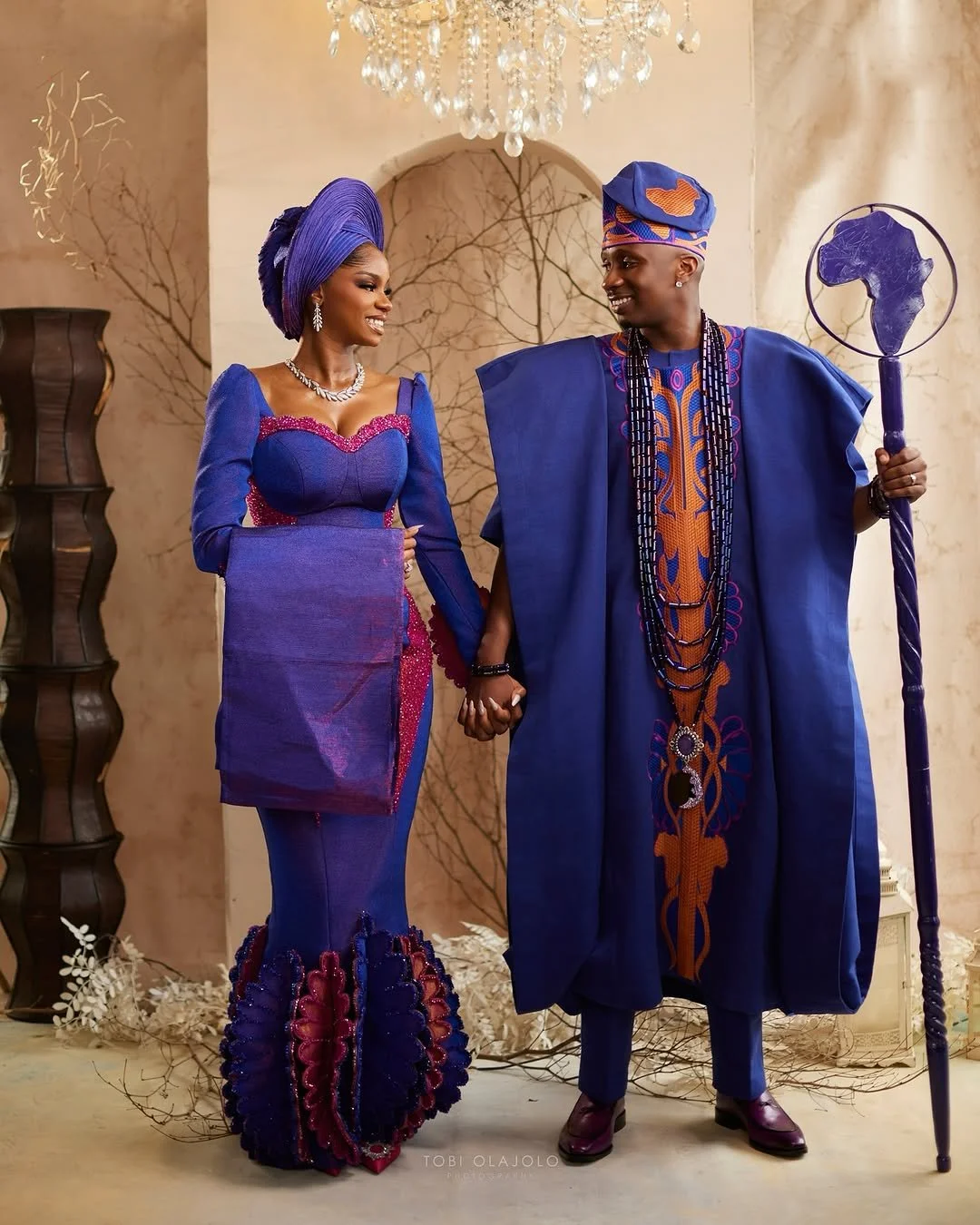ÀȘO ÒKÈ: The Pride Of Yoruba Fashion
Where culture meets couture, the Yoruba people dazzle in àșo-òkè elegance at every occasion.
Àșo-òkè is a traditional, hand-woven fabric from the Yoruba people in southwestern Nigeria. The name Àșo-Òkè translates to “Top Cloth,” signifying its high status, and can be called “Ofi” or “Aso-Ofi”. Historically, it originated from Iseyin in Oyo State, known as the “Home of Àșo-Òkè.” In the 15th Century, it was worn by high-status individuals, including Kings, Chiefs, and other high-ranking figures, for notable events such as traditional festivals and chieftaincy ceremonies to signify High Status and wealth in the Yoruba community.
The Artful Process Behind Àșo-Òkè
For centuries, the Yoruba people have mastered the art of transforming raw materials into a fabric that embodies elegance and artistry. Àso-òkè was traditionally woven by men in the past, using materials such as locally sourced cotton (done by the women), silk from caterpillars, and indigo dye. However, synthetic fibers are now used to reduce the weight of the fabric.
The tools used for the weaving of the design include Akata (proppeller), Iye (the long Wheel), Akaro (Short Wheel), okuku and kokogun (Rollers), Asa (Strikers), Omu (extender used in holding the reel), and Sanrin (Metallic Peg), Ofi ( loom), Oko, Itese (pedal)
Here’s a step-by-step journey into creating this fabric:
Sourcing of natural fiber (cotton): This process involves harvesting cotton after it has been planted. The Yoruba women are often involved in sourcing cotton for the production of àso-òkè.
Ginning (seed separation): This process involves separating cotton fibers from their seeds. The primary purpose of ginning is to clean and prepare the cotton for spinning.
Spinning: The clean cotton is spun into thread or yarn. In modern times, industrially spun cotton or synthetic threads are often used in place of traditional hand-spun cotton.
Weaving: The gathered thread is put into the short wheel (akaro) and inserted into Oko. The thread is passed through the Omu first, then to the asa. The weaving begins by interlacing the thread. Alternating thread colors create the basic pattern of àso-òkè.
After the weaving process, the fabric is assembled and presented in “bundles”. A bundle of Àso-òkè refers to a complete set of narrow woven strips.
For a visual representation of this process, watch this video produced by Josh Olaoluwa and Vincho Nchogu.
Types of Àșo-Òkè
Àso-òkè can be characterized by the weaving technique used, materials used, and patterns; however, color can play a role. There are different types of Àso-òkè, but the traditional fabric is categorized into three main types.
Sanyan: Traditionally, Sayan is made from wild silk, and its beige color or champagne tone characterizes it. The weaving pattern includes fine, tight plain weaves. It was worn for major events in the past. Over time, synthetic fibers are now used to weave this type of Àsò-òkè.
Etù: The name Etu in Yoruba is derived from the word guinea fowl, reflecting the fabric’s color. The material used is cotton dyed in indigo to give a deep blue color with light stripes.
Alaari: Alaari is typically woven from silk or threads dyed with a vibrant red colour. It is often used for special occasions, such as festivals and royal events. The weaving technique used is often thicker than usual, and the fabric is usually shiny.
One or two bundles of the fabric can be tailored into traditional men’s gowns called agbádá and hats called filà, as well as women’s wrappers (Ìró), blouses (bùbá), gowns like the komole, head ties called gèlè, and a shawl called pele.
A popular Yoruba saying goes, “aso lan ki, ki a to ki eniyan,” which translates to “we greet the cloth before we greet the person.” This phrase highlights the cultural importance of Àso-òkè, as it symbolizes tradition and status in the Socio-Economic space of the Yoruba community.
This rich, handwoven material carries stories, history, and a deep sense of pride reflecting Yoruba heritage.
In many Yoruba families, Mothers pass down their Àșo-òkè to their daughters, gifting it as a passed-down treasure during their wedding ceremony. This gesture signifies a bond between the Mother and the Daughter, as well as the continuation of cultural practices and values. This fabric isn’t only a gift but also a reminder of one’s roots, a tangible connection to the past, and a way to preserve the family legacy for future generations.
Today’s Àso-òkè may be adorned with beads, embroidery, or sequins. These touches elevate the fabric to high fashion while still honoring its heritage.
Àșò-òkè In The Spotlight: Occasions Where Yoruba Elegance Shines in Àșò-Òkè
Traditional Wedding
Yoruba Weddings are full-on fashion fests and Àșò-Òkè is the star from the bride’s stunning Styles that can be Iro and buba or Gown that can be paired with embroidery designs that highlight fabric’s unique texture often accessorized with bold gele (headwrap) and colorful beads to the Groom’s Agbada styled with Fila (men’s Cap) and Opa Ase (staff/rod) that symbolizes elegance and authority. During this ceremony, the close relatives of the couple wear a uniform Àșò-òkè referred to as Àșó-ebi, meaning “family cloth,” to show support and solidarity for the event.
Festivals
The Ojude Oba festival in Ijebu Ode, Nigeria, stands out as another event where the splendor of Àșò-Òkè is on full display. This festival involves elaborate parades where people from Ijebu Land and other states gather to showcase their creativity and social status through their attire: Àșo-Òkè.
Coronation and Royal Events
Kings (Òba) and Queens (Olori), as well as the chiefs of the palace, aren't left out either. Their Àso-òkè is adorned with beads during the Coronation and public ceremony.
However, this fabric is now tailored to contemporary styles for everyday wear, proving that Àso-òkè is still in existence and thriving across generations and tribes.
So, whenever you're rocking it yourself or admire anyone wearing it, remember that it’s not just a fabric; it's the heartbeat of Yoruba fashion.



